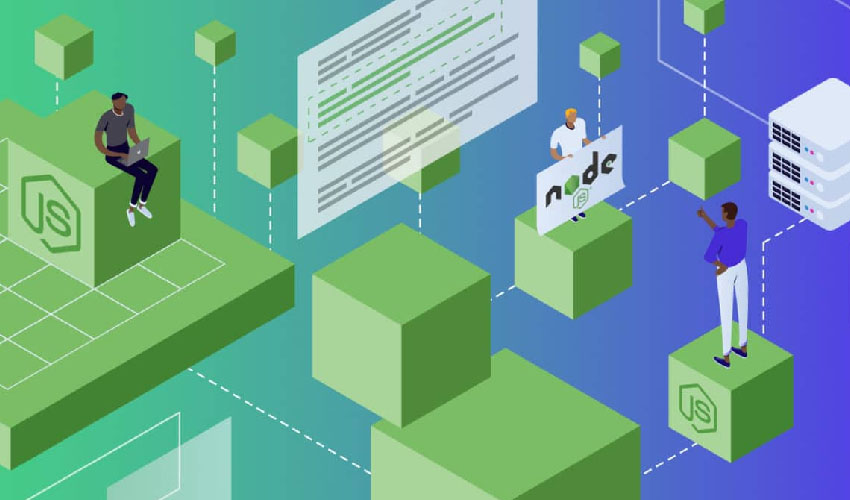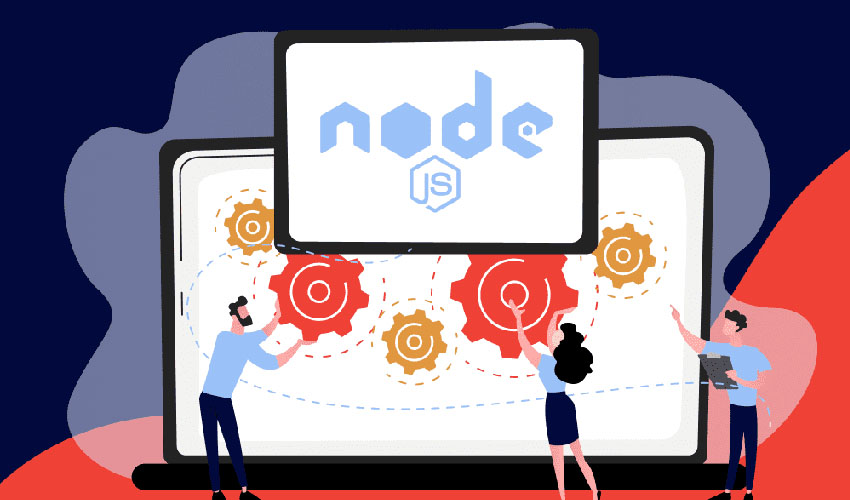Table of Contents
Introduction to Real-Time Apps with Node.js and Express
In an era dominated by dynamic digital experiences, the demand for real-time applications has become ubiquitous. Whether it’s live communication platforms, collaborative tools, or immersive gaming experiences, users expect instant responses and seamless interactions. To cater to these evolving needs, developers turn to the powerful synergy of Node.js and Express, a tandem that revolutionizes the creation of robust, real-time applications.
Understanding Real-Time Applications
Real-time applications, at their core, are software systems that deliver information or content to users with minimal delay, often instantly or near-instantly. They facilitate immediate interaction between users and the application, offering live updates, instant messaging, collaborative editing, and more. These applications are reshaping industries, powering everything from social media platforms to financial trading systems.
The Node.js Paradigm
Node.js, built on Google Chrome’s V8 JavaScript engine, has become a linchpin for real-time application development. Its asynchronous, event-driven architecture allows handling multiple simultaneous connections without blocking, making it ideal for applications requiring high responsiveness. Node.js enables developers to build scalable, data-intensive, and real-time applications efficiently.
Unveiling Express: The Expressive Framework
Complementing Node.js, Express is a fast, minimalist, and flexible Node.js web application framework that simplifies the development of web applications and APIs. It provides a robust set of features for building single-page, multi-page, and hybrid web applications. With its middleware structure and easy routing, Express streamlines the development process, allowing developers to focus on application logic rather than routine tasks.
Real-Time Capabilities: Leveraging WebSockets
Real-time applications thrive on instant communication between clients and servers. Technologies like WebSockets, supported by Node.js and Express, enable bidirectional communication, allowing servers to push updates to clients instantly. This paves the way for features such as live chats, collaborative editing, real-time analytics, and live streaming, enhancing user engagement and experience.
Scalability: Meeting Growing Demands
Scalability is imperative for real-time applications, especially those anticipating rapid user growth. Node.js’ ability to handle concurrent connections efficiently and Express’ lightweight architecture make scaling applications easier. Horizontal scaling across multiple servers or nodes becomes seamless, allowing applications to manage increased traffic and user interactions without compromising performance.
Best Practices in Real-Time App Development
- Efficient Use of Middleware: Leveraging Express’ middleware feature for integrating functionalities like authentication, logging, and error handling simplifies development and ensures code maintainability.
- Performance Optimization: Utilizing Node.js’ asynchronous nature, employing caching mechanisms, optimizing code, and using high-performance libraries enhance app performance.
- Security Measures: Implementing robust security practices such as input validation, encryption, and adhering to security protocols protects real-time applications from potential vulnerabilities.
Use Cases and Industry Impact
Real-time applications powered by Node.js and Express have made significant impacts across various industries. From e-commerce platforms providing real-time inventory updates to healthcare systems facilitating live telemedicine consultations, the applications are vast and diverse. Additionally, industries like gaming, finance, IoT, and communication heavily rely on real-time applications for their functionalities.
Future Trends and Possibilities
The landscape of real-time applications continues to evolve. Emerging technologies like serverless architectures, edge computing, and advancements in AI and machine learning will further revolutionize real-time app development. Moreover, the integration of WebRTC (Web Real-Time Communication) and the adoption of GraphQL for efficient data exchange present promising avenues for future development.
Industries Leveraging Real-Time Apps
In the digital era, the evolution of real-time applications has reshaped numerous industries, revolutionizing how businesses operate, interact with customers, and deliver services. These applications, driven by cutting-edge technologies, have become pivotal in enhancing user experiences, streamlining processes, and enabling instantaneous communication. Let’s explore the diverse array of industries leveraging the power of real-time apps:
1. Healthcare
Real-time applications in healthcare have transformed patient care and management. From telemedicine platforms enabling remote consultations to real-time monitoring of vital signs through wearable devices, these apps ensure timely interventions, enhance diagnostics, and improve overall patient outcomes.
2. Finance and Trading
In the financial sector, real-time apps are a game-changer. Trading platforms execute transactions in milliseconds, monitoring market fluctuations and providing up-to-the-second data analysis. Real-time fraud detection systems help prevent fraudulent activities by swiftly identifying suspicious transactions.
3. Communication and Social Media
Instant messaging, live video streaming, and social media platforms heavily rely on real-time applications. They enable users worldwide to interact seamlessly, share content instantly, and receive live updates, fostering a sense of connectivity and engagement.
4. Transportation and Logistics
The transportation industry benefits immensely from real-time apps. GPS-based navigation systems provide real-time traffic updates, optimize routes, and improve fleet management. Delivery services utilize real-time tracking, offering customers live updates on their package whereabouts.
5. Gaming and Entertainment
Real-time applications have revolutionized the gaming industry by providing immersive and interactive experiences. Multiplayer online games, streaming platforms, and virtual reality applications rely on real-time functionalities to offer seamless gameplay and content delivery.
6. Manufacturing and IoT
In manufacturing, real-time applications integrated with Internet of Things (IoT) devices enhance efficiency and productivity. These apps monitor machinery in real-time, predict maintenance needs, and optimize production schedules, minimizing downtime and improving overall operations.
7. Education and E-learning
Real-time applications have transformed the education sector. Virtual classrooms, interactive learning platforms, and real-time collaboration tools enable students and educators to engage dynamically, fostering effective remote learning experiences.
8. Retail and E-commerce
E-commerce platforms utilize real-time applications for personalized recommendations, inventory management, and real-time order tracking. Chatbots offer instant customer support, enhancing the shopping experience and increasing customer satisfaction.
9. Energy and Utilities
Real-time apps in the energy sector monitor and manage power grids, enabling real-time analysis of energy consumption, predictive maintenance, and quick response to outages, ensuring uninterrupted supply and optimizing resources.
10. Sports and Fitness
From fitness tracking apps providing real-time health data to sports applications offering live match updates and statistics, real-time technology enhances user engagement, fosters competition, and promotes a healthier lifestyle.
Benefits of Node.js and Express for Real-Time Functionality
In the realm of modern web development, the demand for real-time applications that offer seamless interactivity and instant data updates is skyrocketing. To meet this demand, developers often turn to Node.js and Express, a powerful duo that brings a myriad of benefits when building real-time functionality into applications.
1. Asynchronous Architecture of Node.js
Node.js, built on Chrome’s V8 JavaScript engine, is acclaimed for its asynchronous, event-driven architecture. This design allows handling multiple client requests concurrently without blocking the execution thread, making it ideal for real-time applications. Its non-blocking I/O operations enhance the efficiency and responsiveness of applications, enabling developers to create systems capable of handling large volumes of simultaneous connections without performance degradation.
2. Real-Time Communication with WebSockets
Real-time applications heavily rely on continuous communication between the client and server. Node.js, in conjunction with libraries like Socket.io, facilitates real-time bidirectional communication using WebSockets. This technology enables instant data transmission between the client and server, fostering the creation of live chat applications, collaborative tools, gaming platforms, and more, where instant updates are pivotal.
3. Express: Simplifying Development
Express, a minimalist web application framework for Node.js, expedites the development process by providing a robust set of features. Its middleware architecture streamlines tasks like routing, handling HTTP requests, and integrating third-party services, allowing developers to focus on the core functionality of their real-time applications. Express’ flexibility enables the creation of RESTful APIs, simplifying data exchange between clients and servers.
4. Scalability and Performance Optimization
Node.js, coupled with Express, offers scalability by allowing horizontal scaling through the deployment of multiple nodes. This distributed approach enables handling increased traffic and user interactions effortlessly. Additionally, optimizing performance becomes feasible by utilizing Node.js’ asynchronous nature, employing caching mechanisms, optimizing code, and leveraging high-performing libraries. These strategies enhance the overall speed and responsiveness of real-time applications.
5. Community Support and Ecosystem
The Node.js and Express community actively contribute to a vast ecosystem of libraries, modules, and tools. This extensive support system provides developers with a rich array of resources, reducing development time and fostering innovation. The availability of well-documented libraries and frameworks simplifies complex tasks, allowing developers to focus on implementing real-time features and functionalities effectively.
Best Practices for Leveraging Node.js and Express for Real-Time Apps
- Use of Middleware: Leveraging Express’ middleware structure for integrating functionalities like authentication, logging, and error handling streamlines the development process and ensures modularity.
- Caching and Optimizations: Implementing caching strategies, optimizing code, and utilizing efficient libraries enhances the performance and responsiveness of real-time applications.
- Scalability Planning: Architecting applications with scalability in mind, such as utilizing Node.js’ event-driven model for horizontal scaling, prepares applications for handling increased user loads.
- Security Measures: Implementing robust security practices, such as data validation, encryption, and adhering to security best practices, safeguards real-time applications from vulnerabilities and attacks.
Key Features of Real-Time Apps
Creating real-time applications involves a sophisticated orchestration of technologies and frameworks to ensure seamless, instant, and synchronized interactions between users and systems. These apps have become a cornerstone of modern digital experiences, offering live updates, instant messaging, collaborative editing, live streaming, and more. The key features that define the essence of real-time apps revolve around their ability to provide instantaneous communication, live data updates, scalability, and user engagement.
Instantaneous Communication
Real-time applications excel in delivering instant communication channels, allowing users to interact in real-time. Technologies like WebSockets, long polling, and server-sent events enable bidirectional communication between clients and servers. Whether it’s live chat platforms, video conferencing tools, or multiplayer gaming, the ability to exchange information without delay is a fundamental feature of real-time apps.
Live Data Updates
The hallmark of real-time apps lies in their capability to provide live updates. Be it stock market tickers, live sports scores, or collaborative document editing tools, these applications offer real-time data synchronization. Technologies such as Firebase’s real-time database, GraphQL subscriptions, and reactive programming paradigms enable the instantaneous updating of information across multiple clients without manual refreshing, keeping all users in sync with the latest changes.
Scalability and Performance
Real-time apps must handle a high volume of concurrent connections while maintaining responsiveness and performance. Scalability is crucial to accommodate a growing user base without compromising speed or reliability. Node.js, with its event-driven architecture, and frameworks like Express enable horizontal scaling by efficiently distributing the load across multiple instances or nodes. Additionally, caching mechanisms, code optimization, and utilizing CDN (Content Delivery Networks) contribute to improving the performance of real-time applications.
Push Notifications
Push notifications play a pivotal role in keeping users engaged and informed about real-time updates, even when they are not actively using the application. Leveraging technologies like Firebase Cloud Messaging, Apple Push Notification Service (APNS), or Web Push API, real-time apps can send instant alerts or updates to users’ devices, enhancing user engagement and retention.
Collaborative Features
Real-time apps often include collaborative features that enable multiple users to work together in real time. These features facilitate simultaneous editing of documents, whiteboarding, or co-browsing, allowing users to collaborate seamlessly. Technologies like Operational Transformation (OT) or Conflict-Free Replicated Data Types (CRDTs) ensure consistency and resolve conflicts in collaborative environments.
Geolocation and Tracking
Applications that involve real-time location tracking or geolocation services leverage the ability to track and update users’ locations dynamically. Whether it’s ride-sharing apps, location-based gaming, or delivery tracking services, integrating geolocation functionalities in real time enhances user experiences and service reliability.
Security and Reliability
Ensuring the security and reliability of real-time applications is paramount. Implementing encryption, data validation, authentication mechanisms, and adherence to security best practices are crucial to protect sensitive information and maintain the integrity of real-time interactions. Additionally, building in fail-safes, redundancy, and error handling mechanisms ensure reliability and uninterrupted service.
Case Studies: Successful Real-Time Apps
Real-time applications have revolutionized industries across the globe, enhancing user experiences and transforming the way we interact with technology. Let’s delve into several case studies that highlight the immense impact of real-time apps in diverse sectors.
1. WhatsApp: Redefining Instant Messaging
Overview: WhatsApp, founded in 2009, disrupted the communication landscape by introducing a real-time messaging platform accessible across various devices. The app’s seamless integration of real-time messaging, image, and video sharing quickly gained global popularity.
Key Features:
- Instant Messaging: The core feature allowing users to exchange text messages instantly, fostering real-time conversations.
- Read Receipts: Displaying when a message has been read in real-time, enhancing user engagement and responsiveness.
- Multimedia Sharing: Enabling users to share images, videos, and documents swiftly.
Impact: With over 2 billion active users, WhatsApp demonstrates how real-time communication has become an integral part of everyday life, transforming the way people connect and communicate globally.
2. Uber: Transforming Transportation with Real-Time Tracking
Overview: Uber, founded in 2009, disrupted the transportation industry by introducing real-time ride-hailing services through a mobile app. Real-time tracking and efficient matching of drivers and passengers became its hallmark.
Key Features:
- Real-Time Tracking: Providing users with live updates on the location and estimated time of arrival of their ride.
- Dynamic Pricing: Adjusting fares based on demand in real-time, optimizing supply and demand equilibrium.
- Seamless Matching: Instantly connecting riders with nearby available drivers through the app’s real-time algorithms.
Impact: Uber’s real-time approach to transportation revolutionized the industry, offering convenience, reliability, and transparency to users worldwide.
3. Google Docs: Collaborative Real-Time Editing
Overview: Google Docs, introduced in 2006, reshaped collaborative document editing by allowing multiple users to work on a document simultaneously in real time, irrespective of location.
Key Features:
- Real-Time Editing: Enabling multiple users to edit, comment, and collaborate on documents simultaneously.
- Synchronous Updates: Displaying changes made by collaborators instantly, fostering seamless collaboration.
- Revision History: Tracking edits and allowing users to revert to previous versions in real time.
Impact: Google Docs exemplifies how real-time collaboration tools have transformed remote work and collaboration, facilitating seamless teamwork across the globe.
4. Twitch: Live Streaming Redefined
Overview: Twitch, established in 2011, is a live streaming platform that enables users to broadcast and view real-time streams of gaming, music, and other creative content.
Key Features:
- Live Streaming: Allowing content creators to broadcast their content in real-time to a global audience.
- Real-Time Interaction: Enabling viewers to engage with streamers through live chat and interactions during broadcasts.
- Immediate Feedback: Providing instant feedback to content creators through viewer comments and reactions.
Impact: Twitch showcases the power of real-time entertainment, fostering communities and interactions among millions of users globally.
5. Robinhood: Real-Time Stock Trading
Overview: Robinhood, launched in 2013, revolutionized stock trading by providing a user-friendly platform that offers real-time stock market data and enables commission-free trading.
Key Features:
- Real-Time Market Data: Providing users with live updates on stock prices and market movements.
- Instant Trades: Allowing users to execute trades in real-time without traditional brokerage fees.
- Notifications: Sending real-time alerts to users about price changes and market news.
Impact: Robinhood democratized stock trading, making it accessible and user-friendly, catering to a new generation of investors.
Building Real-Time APIs with Express
In the landscape of modern web development, the demand for real-time applications has surged exponentially. From live chat platforms to collaborative tools and interactive gaming experiences, users now expect applications to deliver instantaneous updates and seamless interactions. Node.js, coupled with the Express framework, stands at the forefront of enabling developers to build robust, responsive, and scalable real-time APIs. This comprehensive guide delves into the intricacies of leveraging Express to create dynamic real-time APIs, exploring essential concepts, best practices, and implementation strategies.
Understanding Real-Time APIs and their Significance
Real-time APIs facilitate immediate communication between clients and servers, allowing instant data exchange and updates. These APIs power applications that demand live data streaming, continuous updates, and instantaneous user interactions. The ability to deliver information in real time is crucial in various domains, including financial services, social media, IoT (Internet of Things), and multiplayer gaming.
Leveraging Node.js and Express for Real-Time API Development
Node.js: The Foundation for Real-Time Capabilities
Node.js, built on Chrome’s V8 JavaScript engine, excels in handling asynchronous operations and non-blocking I/O. Its event-driven architecture enables developers to manage multiple client requests concurrently, making it an ideal choice for real-time applications. Node.js facilitates seamless data flow between clients and servers, a fundamental requirement for real-time APIs.
Express: Simplifying API Development
Express, a minimalistic yet robust web application framework for Node.js, streamlines API development. Its middleware architecture, routing capabilities, and extensive module ecosystem accelerate the creation of APIs. Express simplifies request handling, routing, and middleware management, allowing developers to focus on building real-time functionalities rather than low-level server configurations.
Implementing Real-Time Functionality with Express
WebSockets: Facilitating Real-Time Communication
WebSockets, a key technology for real-time applications, enable bidirectional communication between clients and servers. Express, when combined with WebSocket libraries like Socket.io, empowers developers to establish persistent connections, enabling real-time data transmission. This paves the way for features like live chat, live updates, and collaborative editing.
Event Emitters and Event Handling
Express leverages event emitters and event handling mechanisms to manage real-time events efficiently. Developers can emit and listen for events, enabling seamless communication between different parts of the application. This facilitates the broadcasting of real-time data updates to multiple clients simultaneously.
Design Patterns and Best Practices for Real-Time API Development
Scalability and Performance Optimization
Scalability is critical for real-time APIs, considering the potential growth in user interactions. Leveraging Node.js’ ability to handle concurrent connections, developers can horizontally scale applications by distributing the load across multiple instances. Employing caching mechanisms, optimizing code, and utilizing high-performance libraries enhance API performance.
Security Measures for Real-Time APIs
Ensuring the security of real-time APIs is paramount. Implementing measures such as input validation, data encryption, and adherence to security best practices mitigate vulnerabilities. Protection against common threats like cross-site scripting (XSS), cross-site request forgery (CSRF), and injection attacks is crucial to safeguard sensitive data.
Building Robust and Maintainable Real-Time APIs
Middleware Utilization
Express middleware plays a pivotal role in augmenting API functionalities. Integrating middleware components for authentication, error handling, and request validation streamlines development while ensuring robustness and security.
API Documentation and Versioning
Maintaining clear and updated API documentation aids developers in understanding functionalities and endpoints. Versioning APIs appropriately helps manage changes and ensures backward compatibility, preventing disruptions for existing users.




















